Abstract
Recently we have described the existence of high levels of polymeric IgA, partially as immune complexes, in the serum and kidney from patients with IgA mesangial glomerulonephritis. As these patients often have macroscopic haematuria, following upper respiratory tract infections, our working hypothesis in this paper was that circulating lymphocytes from secretory tissues after viral stimulus could produce in these patients a large amount of polymeric IgA. To test it, peripheral blood lymphocytes (PBL) from patients and controls were cultured for seven days in the presence or absence of pokeweed mitogen (PWM). In cell culture supernatants immunoglobulin synthesis was measured by RIA and the proportion of polymeric and monomeric IgA was determined on Ultrogel Ac A22 column. There was no difference in spontaneous production of immunoglobulins between patients and controls. On the contrary, the IgA synthetized by PWM-stimulated PBL was significantly higher in patients than in controls. The percentages of IgA with molecular weight between 600,000 and 250,000 after supernate fractionation were significantly higher in patients than in controls. The true nature of polymeric IgA was confirmed by their ability to bind secretory component, the existence of covalent structures, and the decrease of the larger forms of IgA after reduction and alkylation. The percentage of IgA producing cells binding secretory component was significantly higher in patients than in controls (69 +/- 21 versus 44 +/- 27) after seven days of culture. IgM and IgG produced in patient culture were similar to controls. These results show that mitogen stimulated PBL from patients with Berger's disease synthetized a large amount of true polymeric IgA. It is suggested that a similar situation could occur in vivo after viral of other stimuli.
Full text
PDF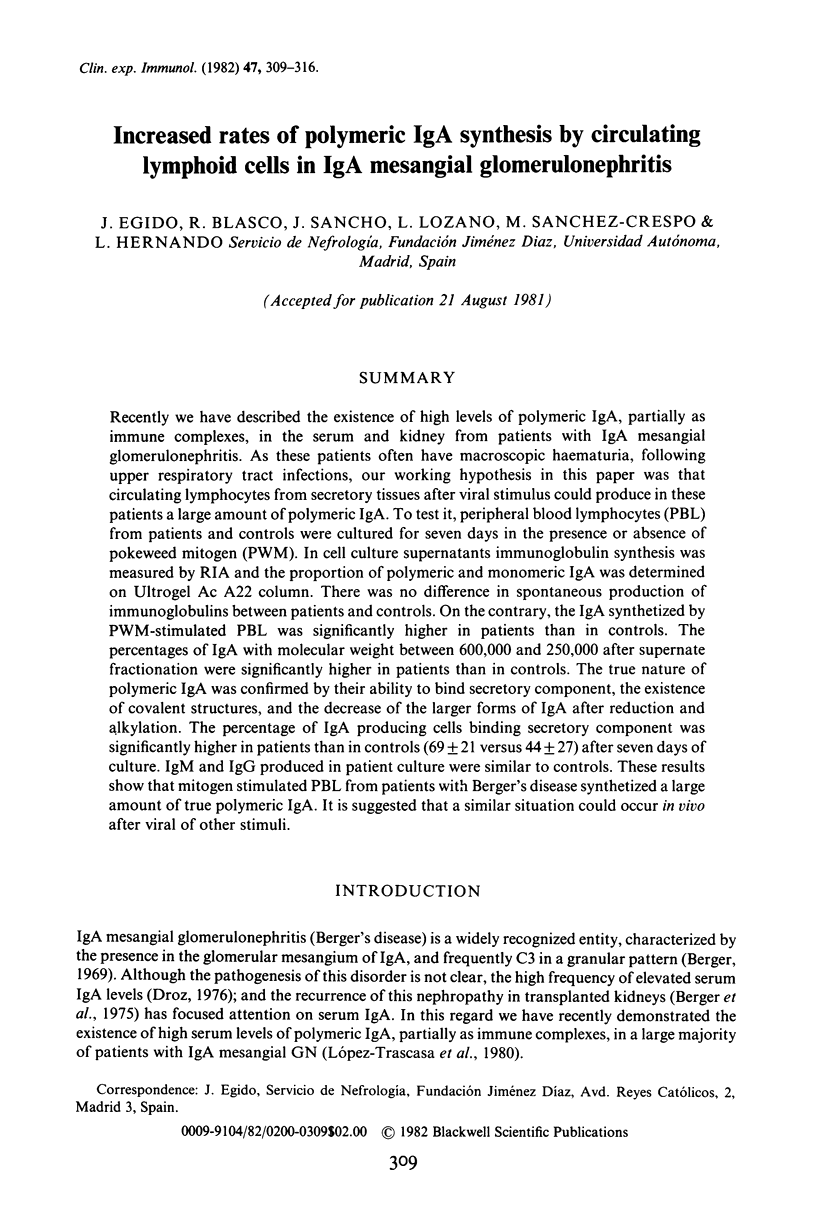
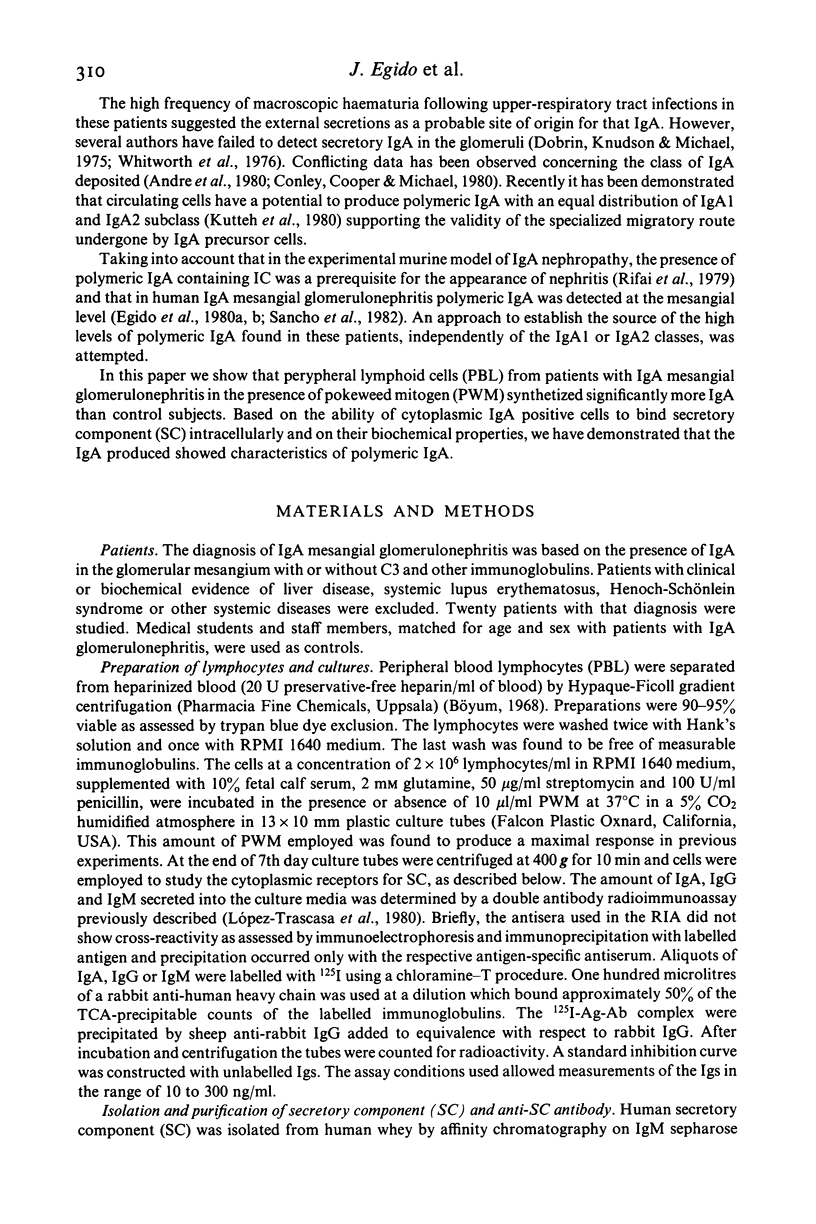
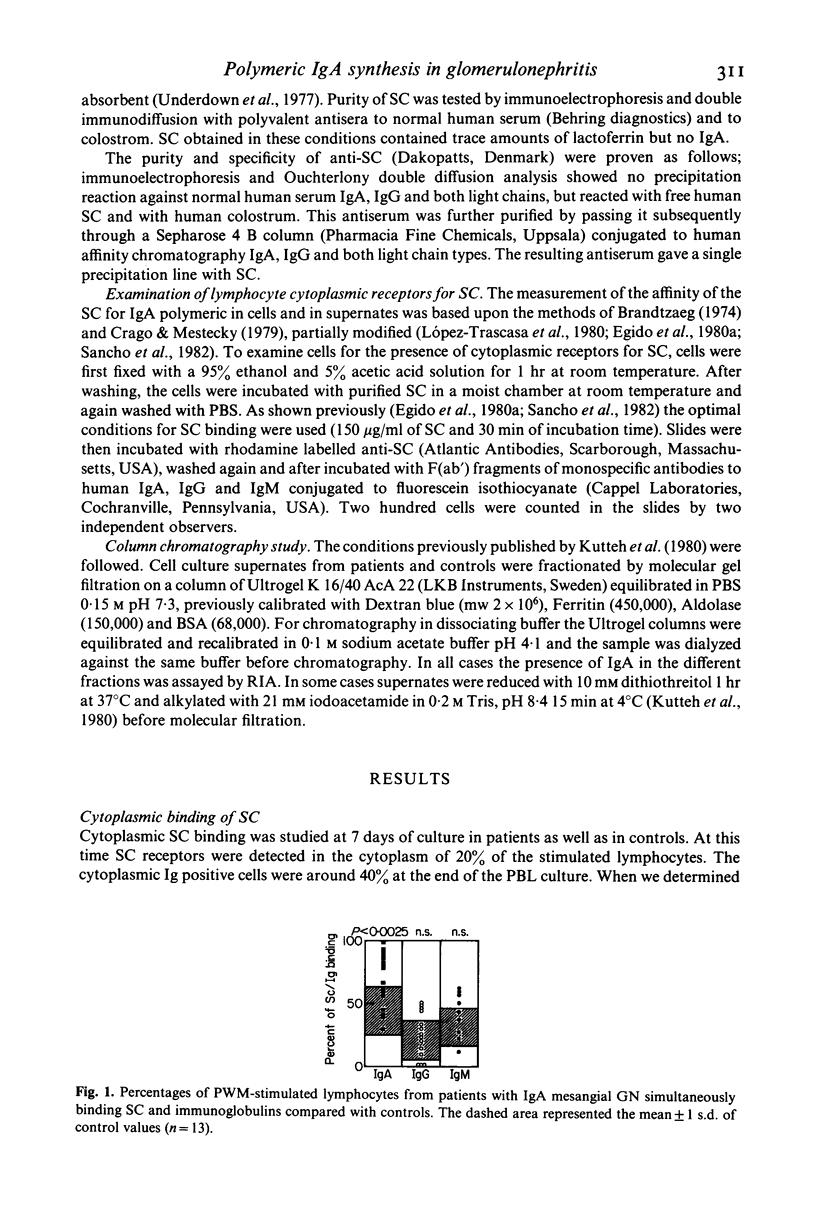
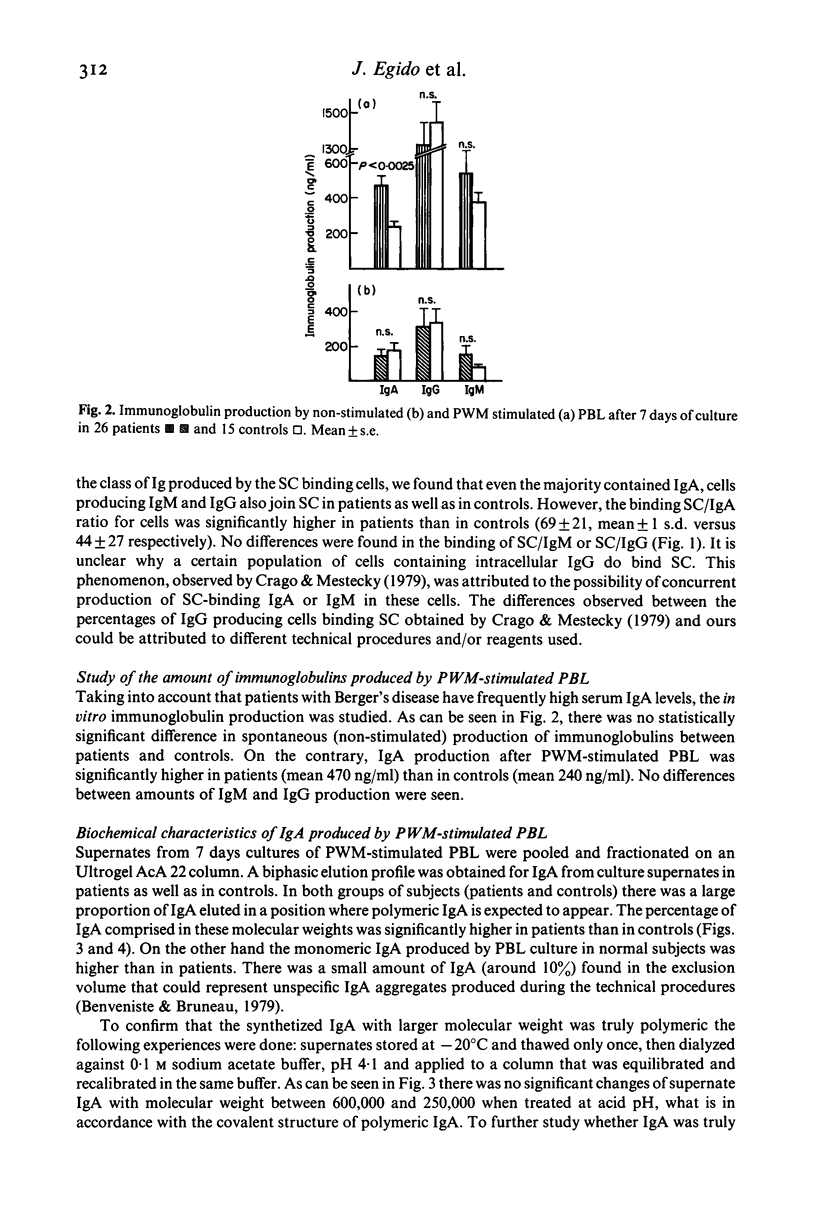
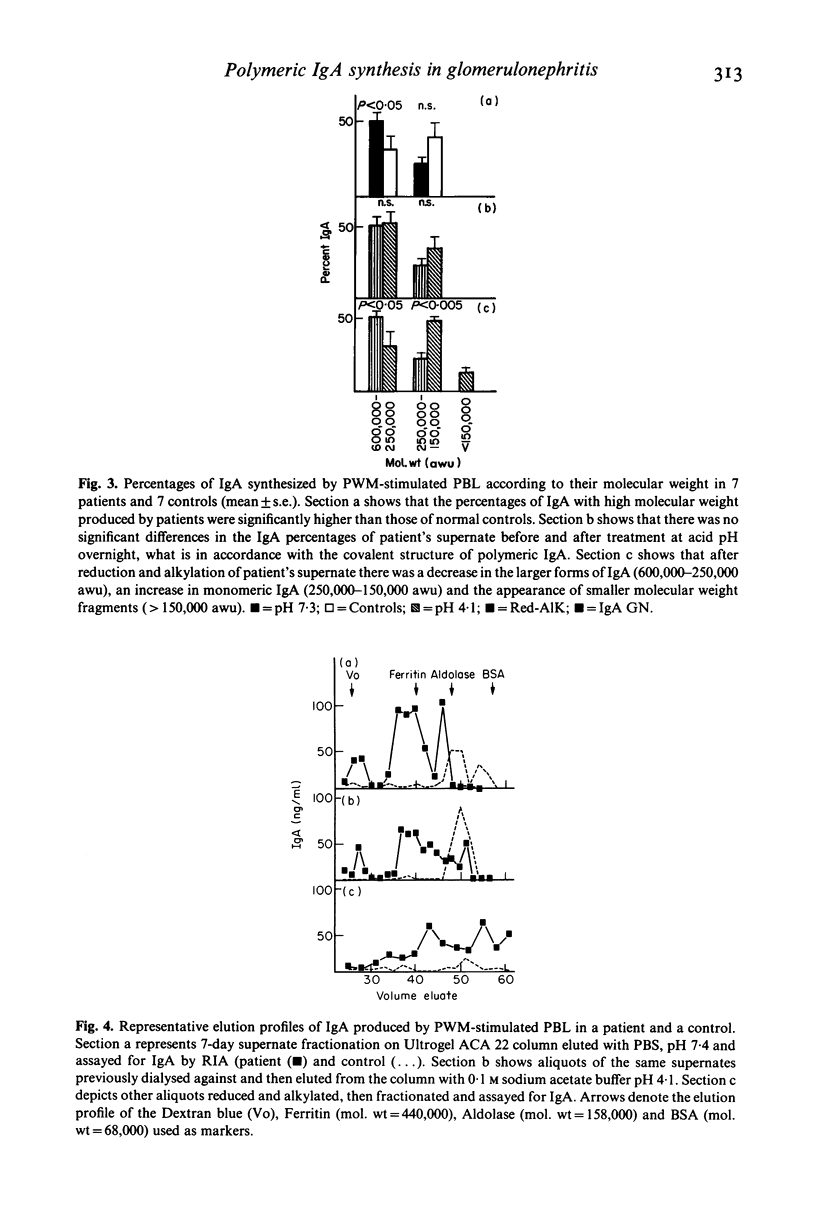
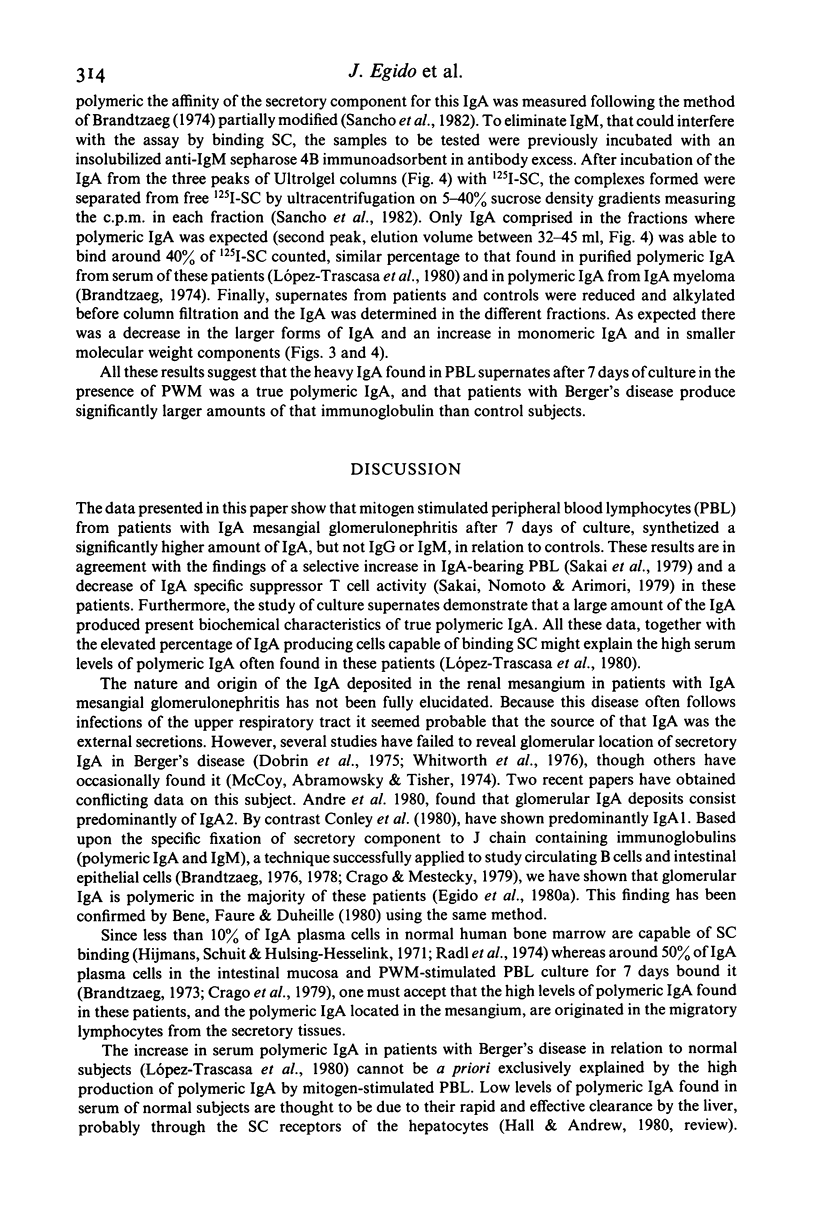
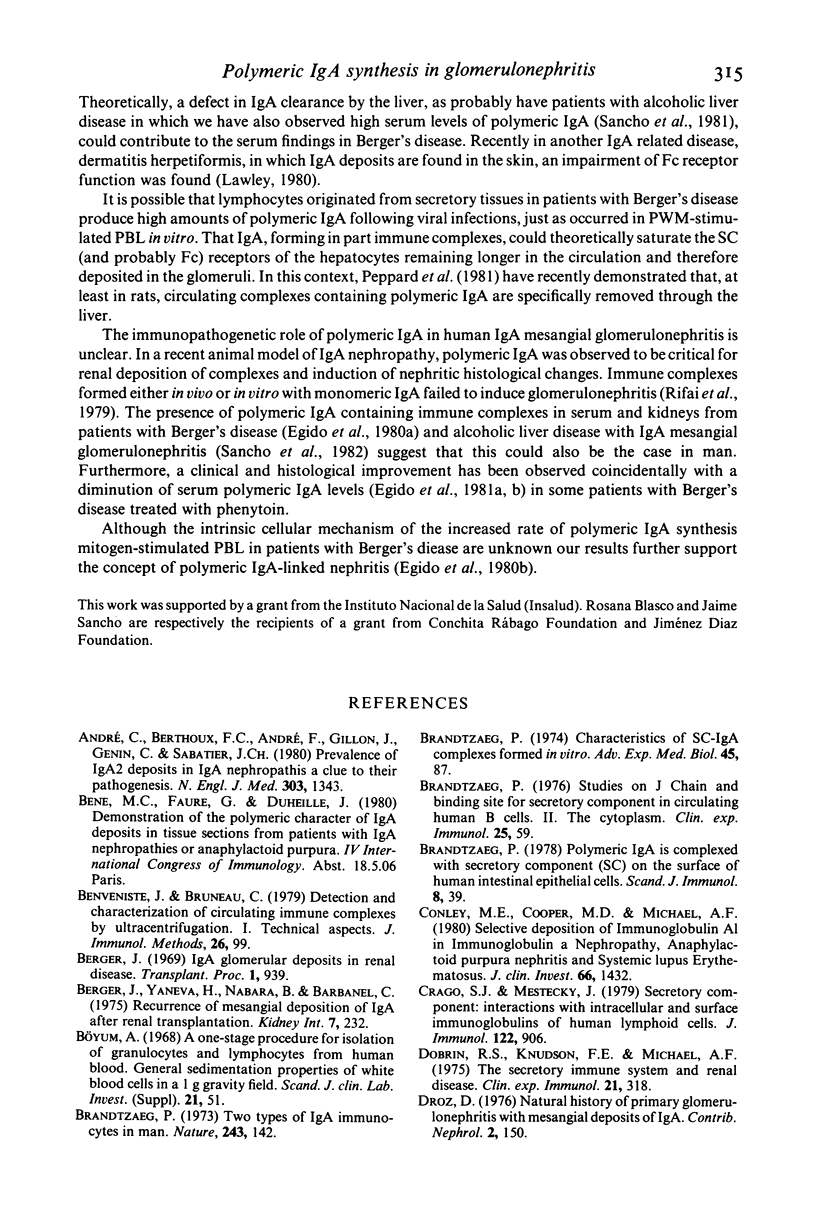

Selected References
These references are in PubMed. This may not be the complete list of references from this article.
- André C., Berthoux F. C., André F., Gillon J., Genin C., Sabatier J. C. Prevalence of IgA2 deposits in IgA nephropathies: a clue to their pathogenesis. N Engl J Med. 1980 Dec 4;303(23):1343–1346. doi: 10.1056/NEJM198012043032306. [DOI] [PubMed] [Google Scholar]
- Benveniste J., Bruneau C. Detection and characterization of circulating immune complexes by ultracentrifugation. Technical aspects. J Immunol Methods. 1979;26(2):99–112. doi: 10.1016/0022-1759(79)90074-7. [DOI] [PubMed] [Google Scholar]
- Berger J. IgA glomerular deposits in renal disease. Transplant Proc. 1969 Dec;1(4):939–944. [PubMed] [Google Scholar]
- Berger J., Yaneva H., Nabarra B., Barbanel C. Recurrence of mesangial deposition of IgA after renal transplantation. Kidney Int. 1975 Apr;7(4):232–241. doi: 10.1038/ki.1975.35. [DOI] [PubMed] [Google Scholar]
- Brandtzaeg P. Characteristics of SC-Ig complexes formed in vitro. Adv Exp Med Biol. 1974;45(0):87–97. doi: 10.1007/978-1-4613-4550-3_10. [DOI] [PubMed] [Google Scholar]
- Brandtzaeg P. Polymeric IgA is complexed with secretory component (SC) on the surface of human intestinal epithelial cells. Scand J Immunol. 1978;8(1):39–52. doi: 10.1111/j.1365-3083.1978.tb00494.x. [DOI] [PubMed] [Google Scholar]
- Brandtzaeg P. Studies on J chain and binding site for secretory component in circulating human B cells. II. The cytoplasm. Clin Exp Immunol. 1976 Jul;25(1):59–66. [PMC free article] [PubMed] [Google Scholar]
- Brandtzaeg P. Two types of IgA immunocytes in man. Nat New Biol. 1973 May 30;243(126):142–143. doi: 10.1038/newbio243142a0. [DOI] [PubMed] [Google Scholar]
- Conley M. E., Cooper M. D., Michael A. F. Selective deposition of immunoglobulin A1 in immunoglobulin A nephropathy, anaphylactoid purpura nephritis, and systemic lupus erythematosus. J Clin Invest. 1980 Dec;66(6):1432–1436. doi: 10.1172/JCI109998. [DOI] [PMC free article] [PubMed] [Google Scholar]
- Crago S. S., Mestecky J. Secretory component: interactions with intracellular and surface immunoglobulins of human lymphoid cells. J Immunol. 1979 Mar;122(3):906–911. [PubMed] [Google Scholar]
- Dobrin R. S., Knudson F. E., Michael A. F. The secretory immune system and renal disease. Clin Exp Immunol. 1975 Aug;21(2):318–328. [PMC free article] [PubMed] [Google Scholar]
- Egido J., Sanchez Crespo M., Sancho J., Hernando L. Phenytoin in the treatment of IgA mesengial glomerulonephritis (Berger's disease) Clin Nephrol. 1981 Mar;15(3):164–165. [PubMed] [Google Scholar]
- Egido J., Sancho J., Mampaso F., Lopez Trascasa M., Sanchez Crespo M., Blasco R., Hernando L. A possible common pathogenesis of the mesangial IgA glomerulonephritis in patients with Berger's disease and Schönlein-Henoch syndrome. Proc Eur Dial Transplant Assoc. 1980;17:660–666. [PubMed] [Google Scholar]
- Hijmans W., Schuit H. R., Hulsing-Hesselink E. An immunofluorescence study on intracellular immunoglobulins in human bone marrow cells. Ann N Y Acad Sci. 1971 Jun 21;177:290–305. doi: 10.1111/j.1749-6632.1971.tb35059.x. [DOI] [PubMed] [Google Scholar]
- Katz S. I., Hall R. P., 3rd, Lawley T. J., Strober W. Dermatitis herpetiformis: the skin and the gut. Ann Intern Med. 1980 Dec;93(6):857–874. doi: 10.7326/0003-4819-93-6-857. [DOI] [PubMed] [Google Scholar]
- Kutteh W. H., Koopman W. J., Conley M. E., Egan M. L., Mestecky J. Production of predominantly polymeric IgA by human peripheral blood lymphocytes stimulated in vitro with mitogens. J Exp Med. 1980 Nov 1;152(5):1424–1429. doi: 10.1084/jem.152.5.1424. [DOI] [PMC free article] [PubMed] [Google Scholar]
- McCoy R. C., Abramowsky C. R., Tisher C. C. IgA nephropathy. Am J Pathol. 1974 Jul;76(1):123–144. [PMC free article] [PubMed] [Google Scholar]
- Peppard J., Orlans E., Payne A. W., Andrew E. The elimination of circulating complexes containing polymeric IgA by excretion in the bile. Immunology. 1981 Jan;42(1):83–89. [PMC free article] [PubMed] [Google Scholar]
- Radl J., Schuit H. R., Mestecky J., Hijmans W. The origin of monomeric and polymeric forms of IgA in man. Adv Exp Med Biol. 1974;45(0):57–65. doi: 10.1007/978-1-4613-4550-3_7. [DOI] [PubMed] [Google Scholar]
- Rifai A., Small P. A., Jr, Teague P. O., Ayoub E. M. Experimental IgA nephropathy. J Exp Med. 1979 Nov 1;150(5):1161–1173. doi: 10.1084/jem.150.5.1161. [DOI] [PMC free article] [PubMed] [Google Scholar]
- Sakai H., Nomoto Y., Arimori S. Decrease of IgA-specific suppressor T cell activity in patients with IgA nephropathy. Clin Exp Immunol. 1979 Nov;38(2):243–248. [PMC free article] [PubMed] [Google Scholar]
- Sakai H., Nomoto Y., Arimori S., Komori K., Inouye H., Tsuji K. Increase of IgA-bearing peripheral blood lymphocytes in families of patients with IgA nephropathy. Am J Clin Pathol. 1979 Sep;72(3):452–456. doi: 10.1093/ajcp/72.3.452. [DOI] [PubMed] [Google Scholar]
- Sancho J., Egido J., Sánchez-Crespo M., Blasco R. Detection of monomeric and polymeric IgA containing immune complexes in serum and kidney from patients with alcoholic liver disease. Clin Exp Immunol. 1982 Feb;47(2):327–335. [PMC free article] [PubMed] [Google Scholar]
- Trascasa M. L., Egido J., Sancho J., Hernando L. IgA glomerulonephritis (Berger's disease): evidence of high serum levels of polymeric IgA. Clin Exp Immunol. 1980 Nov;42(2):247–254. [PMC free article] [PubMed] [Google Scholar]
- Underdown B. J., DeRose J., Koczekan K., Socken D., Weicker J. Isolation of human secretory component by affinity chromatography on IgM-sepharose. Immunochemistry. 1977 Feb;14(2):111–118. doi: 10.1016/0019-2791(77)90289-0. [DOI] [PubMed] [Google Scholar]
- Whitworth J. A., Leibowitz S., Kennedy M. C., Cameron J. S., Chantler C. IgA and glomerular disease. Clin Nephrol. 1976 Jan;5(1):33–36. [PubMed] [Google Scholar]


